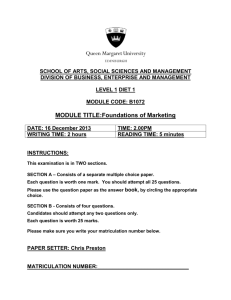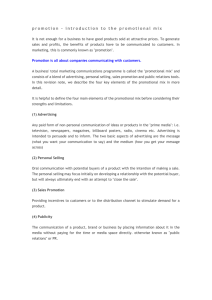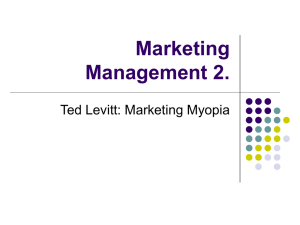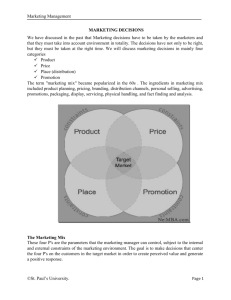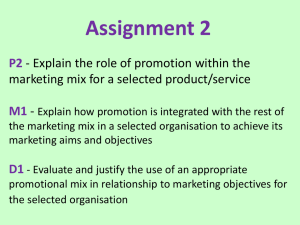Foundations of Marketing: B1072: 2012/13 Exam Paper This
advertisement
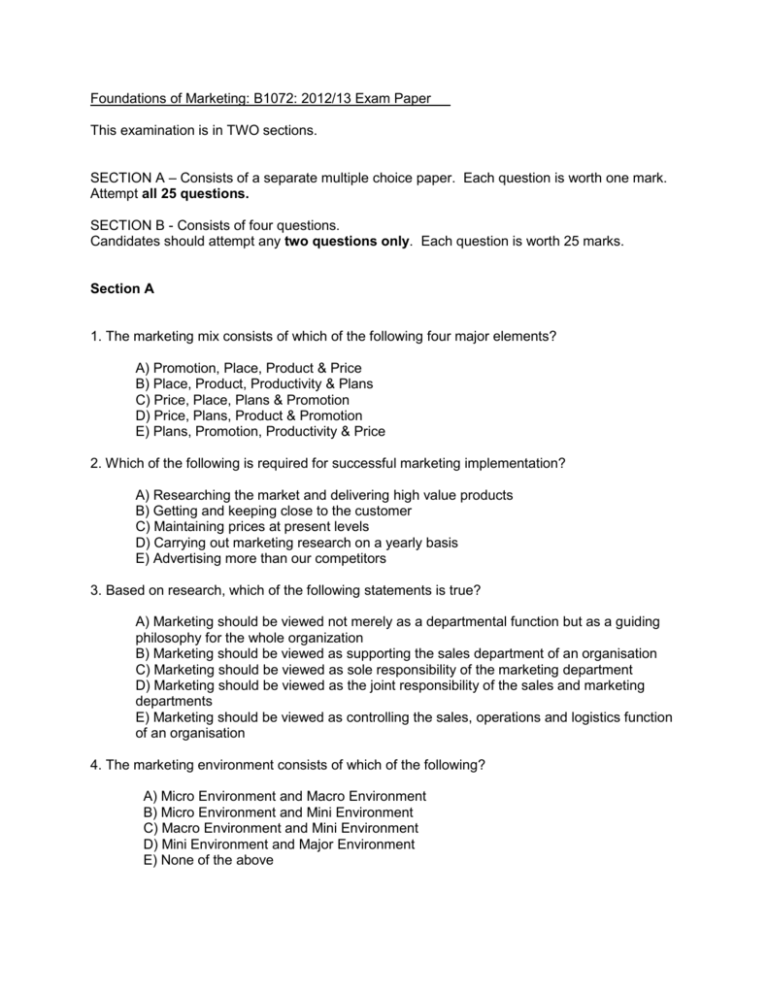
Foundations of Marketing: B1072: 2012/13 Exam Paper This examination is in TWO sections. SECTION A – Consists of a separate multiple choice paper. Each question is worth one mark. Attempt all 25 questions. SECTION B - Consists of four questions. Candidates should attempt any two questions only. Each question is worth 25 marks. Section A 1. The marketing mix consists of which of the following four major elements? A) Promotion, Place, Product & Price B) Place, Product, Productivity & Plans C) Price, Place, Plans & Promotion D) Price, Plans, Product & Promotion E) Plans, Promotion, Productivity & Price 2. Which of the following is required for successful marketing implementation? A) Researching the market and delivering high value products B) Getting and keeping close to the customer C) Maintaining prices at present levels D) Carrying out marketing research on a yearly basis E) Advertising more than our competitors 3. Based on research, which of the following statements is true? A) Marketing should be viewed not merely as a departmental function but as a guiding philosophy for the whole organization B) Marketing should be viewed as supporting the sales department of an organisation C) Marketing should be viewed as sole responsibility of the marketing department D) Marketing should be viewed as the joint responsibility of the sales and marketing departments E) Marketing should be viewed as controlling the sales, operations and logistics function of an organisation 4. The marketing environment consists of which of the following? A) Micro Environment and Macro Environment B) Micro Environment and Mini Environment C) Macro Environment and Mini Environment D) Mini Environment and Major Environment E) None of the above 5. Demographic forces affect which of the following? A) Changes in price B) Changes in population C) Changes in technology D) Changes in the marketplace E) Changes in climate 6. The process of monitoring and analysing the marketing environment of a company is called: A) Situational Analysis B) Market Analysis C) Market Scanning D) Environmental Scanning E) Marketing Monitoring Systems 7. Understanding customers’ behaviour influences which of the following? A) The nature of the marketing mix and how to compete effectively against competitors B) The choice of products offered and the nature of the marketing mix developed to serve it C) The choice of target market and the nature of the marketing mix developed to serve it D) The nature of the marketing mix and how much marketing resources are required E) None of the above 8. What is “cognitive dissonance”? A) When customers experience some post-purchase concerns B) When customers experience information overload prior to purchase C) When customers feel that the risk of purchase is too great D) When customers receive conflicting information about a product/service from a variety of sources E) When customers crave a product, but the purchase of the product is not within their financial means 9. Qualitative research aims to establish which of the following? A) Aims to establish sales, profit and market share levels within an industry B) Aims to establish sales and market share levels within an industry C) Aims to establish customers’ attitudes, values, behaviour and beliefs D) Aims to establish competitors’ attitudes, values, behaviour and beliefs E) All of the above 10. A document defining what the marketing research agency promises to do for its client and how much it will cost is called which of the following? A) Agency briefing B) Marketing plan C) Research brief D) Research proposal E) Marketing research report 11. What is the purpose of segmentation? A) To identify differences in behaviour that has implications for marketing decisions B) To identify the most profitable consumer segments C) To target segments that are not targeted by competitors D) To target segments which match our product/service attributes E) To target and identify segments which are not catered for at all 12. Psychographic segmentation divides the market by: A) Location or region B) Age, gender and family life stage C) Perceptions, beliefs and values D) Lifestyle and personality E) None of the above 13. A company who develops a single marketing mix for the whole market and doesn’t segment the market uses which of the following marketing strategies? A) Niche Marketing B) Differentiated Marketing C) Undifferentiated Marketing D) Customised Marketing E) Focused Marketing 14. Loyal customers tend to be which of the following? A) Less price sensitive B) More price sensitive C) Not price sensitive at all D) Extremely price sensitive E) None of the above statements are true 15. According to the BCG matrix, “Cash Cows” are described as which of the following? A) These are the market leaders in high growth markets B) These are products with a high market share in low growth markets C) These are products which have absorbed large amounts of cash in their launch, however little or no gains have been made in terms of market share D) These are weak products that compete in low growth markets E) These are products which are absorbing large amounts of advertising cash due to stagnant growth 16. Which of the following is not a method of setting prices? A) Competitor-oriented pricing B) Market-led pricing C) Sales-focused pricing D) Cost-based pricing E) All of the above are methods used for setting prices 17. The distribution of products, information and promotional benefits to target consumers through interactive communication in a way, which allows response to be measured, is called which of the following? A) Interactive Marketing B) Channel Management C) Direct Marketing D) Response Marketing E) Targeted Marketing 18. A pull strategy involves which of the following? A) A pull strategy involves an attempt to sell into channel intermediaries (e.g. retailers) and is dependent on personal selling and trade promotions B) A pull strategy involves bypassing intermediaries to communicate to consumers directly C) A pull strategy involves a small promotional expenditure at the start of an advertising campaign, however gradually increasing expenditure to improve the longevity of a campaign D) A pull strategy involves small promotional expenditure throughout the duration of an advertising campaign, due to product unsuitability to advertising campaigns E) None of the above 19. In recent times, the power in marketing channels has transferred to which of the following? A) The distributor B) The manufacturer C) The retailer D) The wholesaler E) The consumer 20. In an online market, which of the following is less likely to occur than in a traditional market? A) Brand switching B) True brand loyalty C) Purchase of goods D) Price as a choice criteria E) Loyalty due to convenience 21. Where publicity is generated from word of mouth recommendations on the Internet or email, this is referred to as which of the following? A) Spam mail B) E-mail publicity marketing C) Viral marketing D) Review marketing E) Direct marketing 22. Corporate social responsibility refers to which of the following? A) Refers to the ethical principle that a person or an organization should be accountable for how its acts might affect the physical environment and the general public B) Refers to that companies need to be aware that they have a responsibility to society and to meet their minimum legal responsibilities C) Refers to companies having “to be seen to be green” in their policies, processes and products D) Refers to companies have to meet all national and international environmental regulations E) Refers to companies who engage in philanthropic activity 23. What is “marketing myopia”? A) Marketing myopia is where management are product focused rather than customer focused B) Marketing myopia is where management fails to respond to technological change C) Marketing myopia is where bureaucratic decision processes occur that stifle responses to change D) Marketing myopia is where a company sees change as threat and therefore defend the status quo E) Marketing myopia is where a company has vertically integrated their channels of distribution 24. The various attributes (and benefits) a customer uses when evaluating products and services are called? A) Price points B) Unmet needs C) Choice criteria D) Purchase criteria E) Met needs 25. In the UK social class is usually measured according to which of the following? A) Occupation B) Wealth C) Background D) Education E) Residence SECTION B Attempt any two question only. Each question is worth 25 marks. Please begin each answer on a new page. 1. Outline the set of activities that the marketer has at their disposal to actively promote their brand, and explain their role within the marketing mix 2. Explain the main methods of marketing research that are available to the marketer when seeking to position their brand appropriately 3. In what ways has social media altered the relationship between marketers and consumers, and explain the role of Facebook for marketers. 4. Discuss products and services where price acts as the major meaningful point of differentiation within a range of products or services
